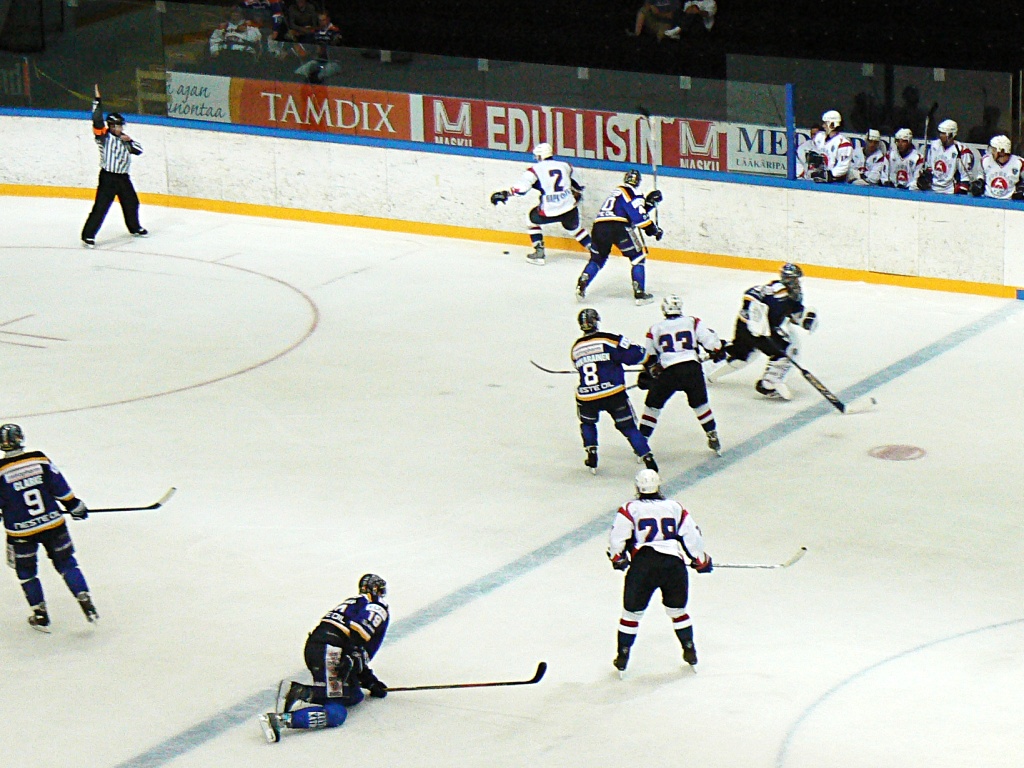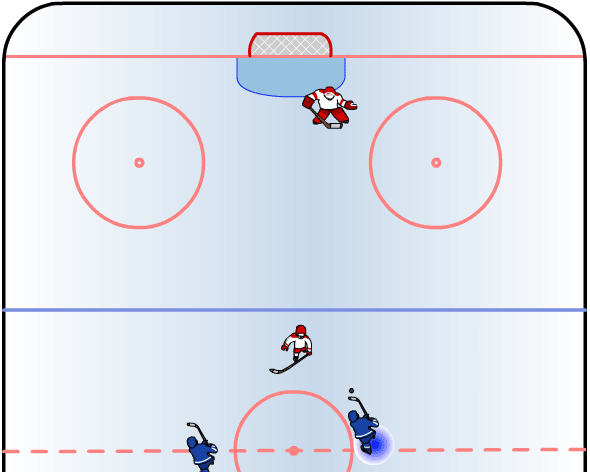|
Ole Eskild Dahlstrøm
Ole Eskild Dahlstrøm (born 4 March 1970 in Oslo, Norway) is a former professional Norwegian ice hockey player. Playing career Dahlstrøm broke onto the Norwegian hockey scene 1987/88 playing for Furuset. The following season, still as a junior aged player, he ended up on the IIHF Division 1 All Star team when he helped Norway to promotion for the 1990 IIHF World Championship in Switzerland. He went to Örebro in the Swedish Division One for the 1988/89 season but came back to his native Furuset after only one season in Sweden. He then played three more seasons for Furuset before signing with Storhamar prior to the 1992/93 season. He scored five goals in his first game for Storhamar against Trondheim. In 527 games with Storhamar he scored 249 goals and 351 assists. Storhamar won five Norwegian Cups in that span. His Storhamar tenure was briefly interrupted when Dahlstrøm went to Adler Mannheim of Germany before the 1997/98 season. He also won the DEL championship that year. ... [...More Info...] [...Related Items...] OR: [Wikipedia] [Google] [Baidu] |
Furuset Ishockey
Furuset Ishockey is an Oslo-based ice hockey club, and a part of the Furuset IF multi-sports club. They play their home games in Furuset Forum. Their team colours are blue and white. History Through different eras Furuset have made their name as one of the greatest hockey clubs in Norway Being one of the founder members of the Norwegian Ice hockey association, they had a head start on many opponents. In December 2008 the club announced that it was on the verge of bankruptcy and that it had informed all players that they were not longer contractually obliged to remain in the club and that the issuance of wages was in jeopardy. Furuset won their first of seven Norwegian Championships in 1949 to start off the first golden era in club history. Led on by the legendary Leif Solheim Leif Sigurd Solheim (born July 14, 1932) is a Norwegian ice hockey player. He played for the Norwegian national ice hockey team, and participated at the Winter Olympics in 1952. He was awarded Gullp ... [...More Info...] [...Related Items...] OR: [Wikipedia] [Google] [Baidu] |
Golden Puck (NIHF)
Gullpucken ( translit. ''the Golden puck'') is awarded by the Norwegian Ice Hockey Federation (NIHF) to the best Norwegian ice hockey player each year. The award is subject to consideration which means it is not necessarily awarded every year. Its inception year was 1959, when Leif Solberg of Furuset became its first recipient. Patrick Thoresen was the last who received the award in 2009. The NIHF also awards the Valemon trophy to the best Norwegian female ice hockey player. It has been awarded twice, the last time was in 2003. Winners *2013: Lars Haugen, HK Dinamo Minsk and Andrea Dalen, North Dakota University *2012: Patrick Thoresen, SKA St. Petersburg *2011: Anders Bastiansen, Färjestad BK *2010: Mats Zuccarello, MODO Hockey *2009: Patrick Thoresen, HC Lugano *2008: Mats Trygg, Kölner Haie *2007: Anders Bastiansen, Mora IK *2006: Tore Vikingstad, DEG Metro Stars *2005: Tommy Jakobsen *2004: ''no award'' *2003: Tommy Jakobsen, DEG Metro Stars *2002: Mats Tr ... [...More Info...] [...Related Items...] OR: [Wikipedia] [Google] [Baidu] |
Hockeyettan
Hockeyettan is the third tier of ice hockey in Sweden. As of the 2015–16 season, the league consists of 46 teams divided geographically into four groups. Hockeyettan operates a system of promotion and relegation with HockeyAllsvenskan and Division 2. From 1944 to 1975, Division I was the highest league in the Swedish ice hockey system, but with the creation of Elitserien (now the SHL) in 1975, it became the second tier. Division I was further relegated to third-tier status in 1999 as HockeyAllsvenskan was spun off into a standalone league, but was frequently written as "Division 1" on the Internet, as it was pronounced "Division One". The league was renamed Hockeyettan for the 2014–15 season. Hockeyettan is the lowest tier to be organized by the Swedish Ice Hockey Association; all men's tiers below Hockeyettan are organized regionally. Format As of the 2015–16 season, the league consists of 48 teams divided into four groups of 12 geographically. The clubs meet each ot ... [...More Info...] [...Related Items...] OR: [Wikipedia] [Google] [Baidu] |
1988–89 Division 1 Season (Swedish Ice Hockey)
1988–89 was the 14th season that Division 1 operated as the second tier of ice hockey in Sweden, below the top-flight Elitserien (now the Swedish Hockey League). Format Division 1 was divided into four starting groups of 10 teams each. The top two teams in each group qualified for the Allsvenskan, while the remaining eight teams had to compete in a qualifying round. The teams were given zero to seven bonus points based on their finish in the first round. The top two teams from each qualifying round qualified for the playoffs. The last-place team in each of the qualifying groups was relegated directly to Division 2, while the second-to-last-place team had to play in a relegation series. Of the 10 teams in the Allsvenskan - in addition to the eight participants from Division 1, the two last place teams from the Elitserien also participated - the top two teams qualified directly for the Allsvenskan final, from which the winner was promoted directly to the Elitserien. The second p ... [...More Info...] [...Related Items...] OR: [Wikipedia] [Google] [Baidu] |
Penalty (ice Hockey)
A penalty in ice hockey is a punishment for an infringement of the rules. Most penalties are enforced by sending the offending player to a penalty box for a set number of minutes. During the penalty the player may not participate in play. Penalties are called and enforced by the referee, or in some cases, the linesman. The offending team may not replace the player on the ice (although there are some exceptions, such as fighting), leaving them short-handed as opposed to full strength. When the opposing team is said to be on a '' power play'', they will have one more player on the ice than the short-handed team. The short-handed team is said to be "on the penalty kill" until the penalty expires and the penalized player returns to play. While standards vary somewhat between leagues, most leagues recognize several common varieties of penalties, as well as common infractions. The statistic used to track penalties is called "penalty minutes" and abbreviated to "PIM" (spoken as singl ... [...More Info...] [...Related Items...] OR: [Wikipedia] [Google] [Baidu] |
Point (ice Hockey)
In ice hockey, point has three contemporary meanings. Personal stat A point is awarded to a player for each goal scored or assist earned. The total number of goals plus assists equals total points. The Art Ross Trophy is awarded to the National Hockey League (NHL) player who leads the league in scoring points at the end of the regular season. Team stat Points are also awarded to assess standings (or rankings). Historically, teams were awarded two points for each win, one point for each tie and no points for a loss. Such a ranking system, implemented primarily to ensure a tie counted as a "half-win" for each team in the standings, is generally regarded as British and/or European in origin and as such adopted by the National Hockey League which was founded in Canada where leagues generally used ranking systems of British origin. Awarding points in the standings contrasts with traditional American ranking systems favored in sports originating within the United States where today th ... [...More Info...] [...Related Items...] OR: [Wikipedia] [Google] [Baidu] |
Assist (ice Hockey)
In ice hockey, an assist is attributed to up to two players of the scoring team who shot, passed or deflected the puck towards the scoring teammate, or touched it in any other way which enabled the goal, meaning that they were "assisting" in the goal. There can be a maximum of two assists per goal. The assists will be awarded in the order of play, with the last player to pass the puck to the goal scorer getting the primary assist and the player who passed it to the primary assister getting the secondary assist. Players who gain an assist will get one point added to their player statistics. Despite the use of the terms "primary assist" and "secondary assist", neither is worth more than the other, and neither is worth more or less than a goal. Assists and goals are added together on a player's scoresheet to display that player's total points. Special cases If a player scores off a rebound given up by a goaltender, assists are still awarded, as long as there is no re-possession by ... [...More Info...] [...Related Items...] OR: [Wikipedia] [Google] [Baidu] |
Goal (ice Hockey)
In ice hockey, a goal is scored when the puck entirely crosses the goal line between the two goal posts and below the goal crossbar. A goal awards one point to the team attacking the goal scored upon, regardless of which team the player who actually deflected the puck into the goal belongs to (see also own goal). Typically, a player on the team attempting to score shoots the puck with their stick towards the goal net opening, and a player on the opposing team called a goaltender tries to block the shot to prevent a goal from being scored against their team. The term goal may also refer to the structure in which goals are scored. The ice hockey goal is rectangular in shape; the front frame of the goal is made of steel tube painted red (blue in the ECHL because of a sponsorship deal with GEICO) and consists of two vertical goalposts and a horizontal crossbar. A net is attached to the back of the frame to catch pucks that enter the goal and also to prevent pucks from entering it ... [...More Info...] [...Related Items...] OR: [Wikipedia] [Google] [Baidu] |
Season (sports)
In an organized sports league, a typical season is the portion of one year in which regulated games of the sport are in session: for example, in Major League Baseball the season lasts approximately from the last week of March to the last week of September. In other team sports, like association football or basketball, it is generally from August or September to May although in some countries - such as Northern Europe or East Asia - the season starts in the spring and finishes in autumn, mainly due to weather conditions encountered during the winter. A year can often be broken up into several distinct sections (sometimes themselves called seasons). These are: a preseason, a series of exhibition games played for training purposes; a regular season, the main period of the league's competition; the postseason, a playoff tournament played against the league's top teams to determine the league's champion; and the offseason, the time when there is no official competition. Preseason ... [...More Info...] [...Related Items...] OR: [Wikipedia] [Google] [Baidu] |
Playoffs
The playoffs, play-offs, postseason or finals of a sports league are a competition played after the regular season by the top competitors to determine the league champion or a similar accolade. Depending on the league, the playoffs may be either a single game, a series of games, or a tournament, and may use a single-elimination system or one of several other different playoff formats. Playoff, in regard to international fixtures, is to qualify or progress to the next round of a competition or tournament. In team sports in the U.S. and Canada, the vast distances and consequent burdens on cross-country travel have led to regional divisions of teams. Generally, during the regular season, teams play more games in their division than outside it, but the league's best teams might not play against each other in the regular season. Therefore, in the postseason a playoff series is organized. Any group-winning team is eligible to participate, and as playoffs became more popular they ... [...More Info...] [...Related Items...] OR: [Wikipedia] [Google] [Baidu] |



